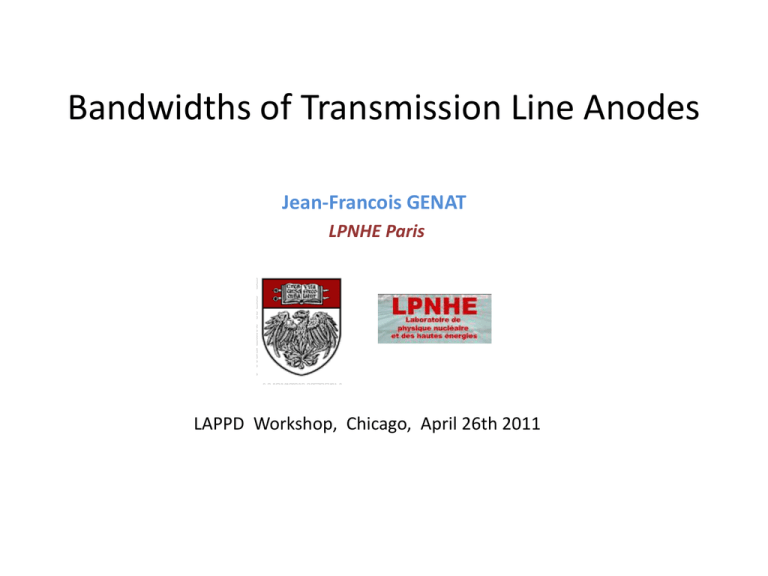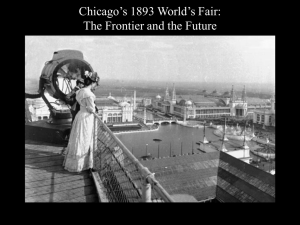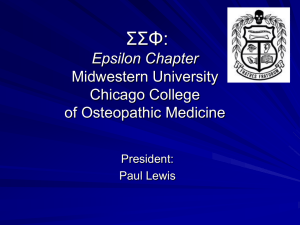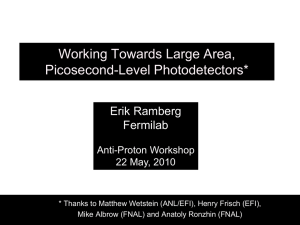Bandwidths_Genat_April_28_2011_new
advertisement

Bandwidths of Transmission Line Anodes Jean-Francois GENAT LPNHE Paris LAPPD Workshop, Chicago, April 26th 2011 LAPPD 8” x 8” Micro-channel Plates Micro-strip Lines Parameters: - Strip width W - Inter-strip distance d - Metal conductivity s - Dielectric constant e r Jean-Francois Genat, LAPPD Workshop, Chicago, April 28th 2011 Timing resolution tr t s 1 0.35t s st SN SN abw Since and st sn dS / dt whith where SN tr dS / dt S s t ,n s t t s / tr (Stefan Ritt) Jean-Francois Genat, LAPPD Workshop, Chicago, April 28th 2011 S sn MCP signals Segmented anodes, Burle-Photonis Rise-time 66ps abw=5.3 GHz Jean-Francois Genat, LAPPD Workshop, Chicago, April 28th 2011 Glass + ALD MCPs (from Matt Wetstein, ANL) MCP ‘nominal’ signals spectra 25 microns at 2 kV, 10 microns at 2.5 kV Data taken at Argonne (Ed May’s laser test stand) Jean-Francois Genat, LAPPD Workshop, Chicago, April 28th 2011 50 Photo-electrons “ ‘Nominal’ Timing resolution (model) Assume: SN = 50 fs= 10 GS/s abw = 1 GHz Tr = .35/abw = 350ps Ts = 1/ fs = 100ps s t 3.74 ps Jean-Francois Genat, LAPPD Workshop, Chicago, April 28th 2011 Skin effect d 1 mfs Resistivity and Skin Depth at 1 GHz Al Au Cu Ag - No need to have more than 10mm metal (~5 x d at 1 GHz) Jean-Francois Genat, LAPPD Workshop, Chicago, April 28th 2011 2.8 nW.m 2.4 mm 2.4 2.4 1.7 2.0 1.6 1.9 Test plate Jean-Francois Genat, LAPPD Workshop, Chicago, April 28th 2011 Measured Microstrip Bandwidth 3dB bandwidth is 3.77GHz for a 8” trace This measured bandwidth agrees with the simulations using HFSS (Mentor-Graphics) Jean-Francois Genat, LAPPD Workshop, Chicago, April 28th 2011 Transmission Lines Bandwidths Two main factors for losses: - Resistance of the metal traces vs 50 W: metal conductivity, skin effect, as d Copper 10 GHz 1 mfs l 0.07 f R l 2Z 0 A 5m copper line has a metal induced 3dB bandwidth of 10 GHz - Dielectric losses: complex dielectric constant e r e ' je " t and l e" e' d tan(d l )(2f )CZ0 / 2 The Borofloat glass loss tangent is unknown at 10 GHz, but we measured it at 3.77 GHz for a 8 ’’ long microstrip line. The loss tangent at 10 GHz can be deduced from this measurement to Jean-Francois Genat, LAPPD Workshop, Chicago, April 28th 2011 tan d l 0.05 Examples with Quartz and Alumina Dielectric losses Example: f=10GHz, tan(d)= 6 10-5 , C=60pF/m, Z0=50W dielectric tan(d l )(2f )CZ0 / 2 The strip length for a 3dB bandwidth is: At 10 GHz: Quartz: Alumina: Jean-Francois Genat, LAPPD Workshop, Chicago, April 28th 2011 Quartz dielectric 0.006 Alumina dielectric 0.01 l 58m 35m ln 2 Thanks ! Borofloat 33 properties Jean-Francois Genat, LAPPD Workshop, Chicago, April 28th 2011 Dielectric constants Dielectric constant Quartz Beryllia Fused Quartz Alumina 96% Alumina 99.5% Glass (Borofloat) RF ceramic Loss tangent 3.8 6.7 3.8 10 9.6 4.6 6.1 Jean-Francois Genat, LAPPD Workshop, Chicago, April 28th 2011 @ 1 GHz 1.15 10-5 1.4 10-5 5 10-5 2.0 10-4 3.0 10-4 10 GHz 3.7 10-3 1 MHz 3 10-3 5.0 10-3 3.7GHz Example: FR4 Microstrip line Losses Dielectric FR4 losses dominate > 200 MHz Conductor losses contribute > 5 GHz Andrew Byers (Tektronix) Jean-Francois Genat, LAPPD Workshop, Chicago, April 28th 2011







